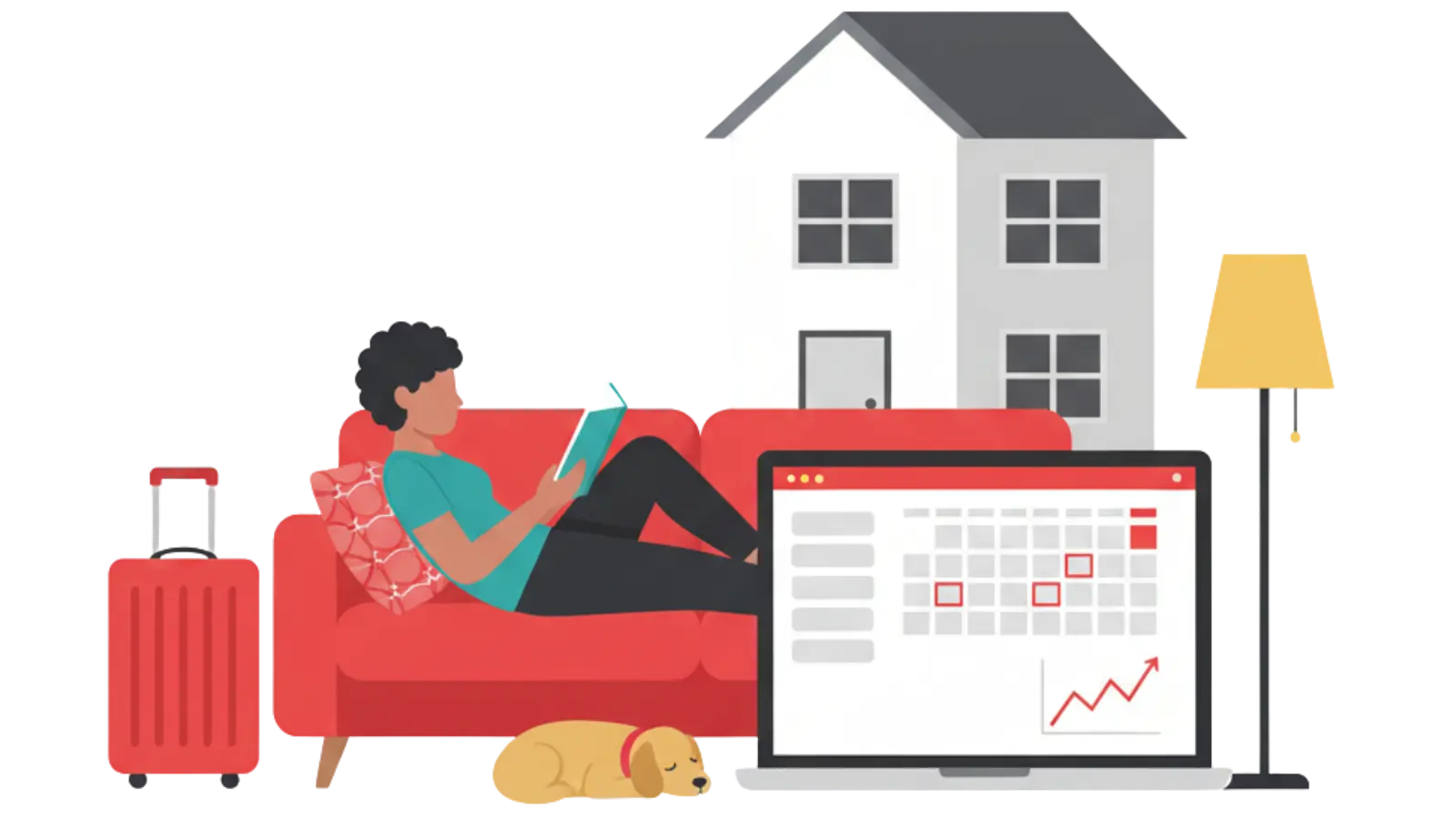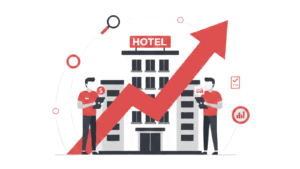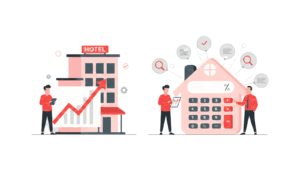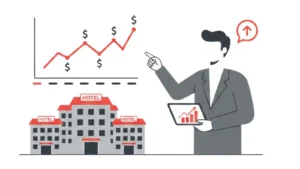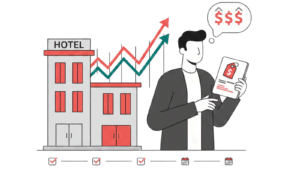Updated : Oct 29, 2025
In an era where travelers seek flexibility, hotels can no longer rely solely on short stays. By adding mid-term rental fashioned stays to your offerings, you can tap into a growing and underserved segment of guests. So, let’s get right into how hotel owners and managers can adopt mid-term rentals to diversify revenue, stabilize occupancy, and outpace competitors.
What Are Mid-Term Rentals in the Hospitality Industry?
Mid-term rentals refer to stays that last longer than typical nightly or weekly stays but shorter than a full-year lease. In most cases, they offer leases ranging from 30 days up to 6 months and sometimes even 9 months. In a hotel context, mid-term furnished rentals mean offering rooms or suites that are fully equipped and serviced for guests who need accommodation for weeks to months.
This strategy is complementary to traditional short-term stays. A hotel can still capture nightly traffic during peak periods but use mid-term rentals to reduce vacancy in slower times or for wings of the property less suited for frequent turnover.
The mid-term rental space is sizable and growing. Currently, the global extended stay market is valued at $62.8 billion, and its value is expected to reach $143.2 billion by 2035. This marks an impressive annual growth of 8.6%. Meanwhile, at the moment only about 10% of hotel rooms in the US market offer extended stays. The growing demand from guests and the still relatively low supply from hoteliers translates into strong potential for savvy hotel owners and managers.
Pros and Cons of Hotel Mid-Term Rentals
| Pros | Cons |
| More stable & predictable revenue Better occupancy rate Less marketing expenses Lowered turnover costs New types of guests Opportunities to upsell | Reduced flexibility More sophisticated amenity requirements Utility cost risk Regulatory complications |
Mid-Term Furnished Rentals Pros for Owners and Managers
- More Stable Revenue: Longer bookings smooth out seasonal ups and downs. Thus, mid-term furnished rentals can be a straightforward revenue management strategy for hoteliers.
- Higher Occupancy Rates: Fewer gaps between stays mean fewer empty rooms, which leads to a better occupancy rate. Introducing mid-term rentals can be an easy strategy to enhance occupancy for independent hotels.
- Lower Marketing Spend: As guests stay longer, you don’t need to constantly chase new bookings. This reduces your hotel digital marketing expenses.
- Reduced Turnover Costs: With less frequent check-ins, cleaning and maintenance expenditure goes down.
- New Guest Segments: Corporate clients, digital nomads, and traveling professionals prefer furnished midterm options, allowing you to extend beyond the typical family guests for hotels.
- Upselling Opportunities: Bundled services like laundry, parking, or coworking access can bring extra income.
Mid-Term Rentals Cons for Owners and Managers (And Quick Fixes)
- Less Flexibility: Committing rooms for months may block high-paying short stays.
Solution: Dedicate only part of your inventory to mid term rentals.
- Higher Amenity Expectations: Guests need kitchens, workspaces, and storage.
Solution: Upgrade selected units with durable, functional furniture. Sustainable practices can help you save on the total cost.
- Utility Cost Risk: Longer stays can drive up usage.
Solution: Add flat amenity fees or caps.
- Regulatory Complexity: Local laws differ for 30+ day stays from place to place.
Solution: Get lead advice and adjust contracts.
Transform your hospitality approach today
Discover actionable strategies tailored for small hotel owners and managers creating unforgettable stays for your guests & expanding revenues for your hotel!
Start your 30-day FREE trial now!Types of Guests Typically Booking Mid-Term Furnished Rentals
Here are the different guests who book mid-term rentals and how you can tailor services to them accordingly:
1. Corporate Travelers
On multi-month projects, corporate travelers need reliable amenities, such as high-speed Wi-Fi and working space, and invoicing. Offer business packages and meeting space.
2. Remote Workers/Digital Nomads
Digital nomads look for strong Wi-Fi, quiet areas, and sometimes a community. Provide work desks and highlight connectivity.
3. Medical Professionals
Traveling nurses and doctors need comfort and connectivity to hospitals. Flexible check-ins and quiet spaces work best.
4. Interns/Students
Students and interns often stay in aparthotels or serviced apartments for a semester or internship. They want affordability and essentials, such as storage. You can partner with colleges and universities in the area for referrals and offer them special discounts and coupons for your hotel.
5. Relocating Families
Families between homes need larger, furnished units. Suites or connecting rooms and child-friendly extras can seal the deal.
How PriceLabs Can Help You Earn More from Your Mid-Term Rentals
Launching mid-term rentals is only half the battle. The real challenge is pricing them right to reap all the potential benefits. Unlike nightly stays, where demand fluctuates daily, mid-term bookings require careful balance. You want rates attractive enough for long-stay guests while still maximizing revenue over time. That’s where PriceLabs comes in.
Minimum Stay Requirement

With PriceLabs, you can easily set up minimum stay requirements to target the 30+ day market and avoid unbookable calendar gaps. You no longer have to manually block or juggle dates. The system automatically aligns your availability with the demands of mid-term renters, based on carefully predetermined rules.
Dynamic Pricing

Pricing becomes more strategic, too. PriceLabs lets you define minimum, base, and maximum rates, ensuring your mid-term rentals are never overpriced during slow months or underpriced when demand spikes. It can design a smart pricing strategy specifically for longer stays, adjusting seasonality and discounts in ways that make the most sense for mid-term bookings.
But the real power of PriceLabs lies in automation. Each day, PriceLabs analyzes demand, competitor trends, and local market conditions, and then updates your prices accordingly. Instead of guessing what a fair monthly rate might be, you can rely on data-driven adjustments that keep your rentals competitive and profitable.
Importantly, your rates are synced across all the websites where you list your hotel including your website for direct bookings. You can connect PriceLabs to your property management system, channel manager, or directly to your system via the API.
Market Dashboard

Finally, the Market Dashboard closes the loop. It provides clear insights into how similar properties are performing, which stay lengths are in demand, and where your hotel can capture more revenue.It gives you clear understanding of metrics like :
- Estimated Revenue
- RevPAR
- Estimated % Occupancy
- ADR
- Active listings
- Bookings
- Booking Window
- Length of stay
How Hotels Can Capture the Midterm Rentals Market Segment?
The hospitality Industry is ever evolving. Can hotels look for stays that are fashioned for mid-term rentals?
1. Adapt Room Configurations for Longer Stays
Hotels can reconfigure certain rooms to better suit guests seeking mid-term rentals. This may involve adding kitchenettes, providing additional storage space, or offering amenities like laundry services. By tailoring these rooms for longer stays, hotels can make themselves more appealing to this demographic and distinguish themselves from competitors.
2. Flexible Pricing Strategies
Implementing a flexible pricing model is crucial for attracting midterm rental guests. Offering discounted rates for extended stays can incentivize bookings while ensuring that rooms are occupied. This strategy not only maximizes revenue but also fosters guest loyalty, as travelers often appreciate cost-effective options without compromising on quality.
3. Enhancing Digital Presence
Increasing visibility in the midterm rentals market requires an enhanced digital presence. Hotels should optimize their websites and third-party listings with keywords like “midterm rentals” to attract potential guests searching for long-term accommodation solutions. Additionally, engaging content and targeted marketing campaigns can help capture the attention of this growing market segment.
4. Partnerships with Local Businesses and Corporations
Establishing partnerships with local businesses and corporations can provide a steady stream of midterm rental guests. By offering exclusive deals or accommodations tailored to corporate clients, hotels can secure consistent bookings from business travelers who require longer stays due to work assignments or projects.
5. Improving Guest Experience for Longer Stays
To successfully capture the midterm rentals market, it’s essential to enhance the overall guest experience for longer stays. This includes personalized services, such as concierge assistance tailored to extended visits, and creating a sense of community through social events or networking opportunities within the hotel. Satisfied guests are more likely to return and recommend the hotel to others seeking similar accommodations.
Wrapping Up
Hotels that embrace mid-term rentals unlock a powerful revenue stream. By offering furnished, flexible stays, you can attract new guest types, improve occupancy, and stabilize income. With PriceLabs’ tools, pricing and revenue optimization become effortless. The future of hotel growth is flexible. Make mid-term rentals part of your strategy today.
FAQs
Are Mid-Term Rentals Always Furnished?
Mid-term rentals are not always furnished, but furnished units are more attractive and competitive for longer stays, especially when it comes to hotels.
What Amenities Do Renters Look for in a Mid-Term Rental?
Most guests expect strong Wi-Fi, a workspace, a kitchen or kitchenette, laundry, and reliable utilities.


